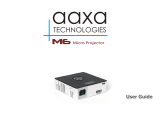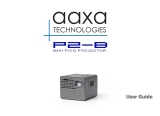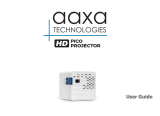Page is loading ...

aaxa
TECHNOLOGIES
User Guide

Caution!
WARNING: Please use this product as instructed. Misuse may cause
injury or death.
DO NOT use while driving
DO NOT expose to water or wet
surfaces. Electric shock may occur.
DO NOT expose the projected LED
image to your eyes or the eyes of
others
DO NOT block or restrict airow
from ventilation holes as this may
cause the projector to overheat
Keep the projector, battery, or
charger away from any heat sources
Caution for Battery Use
• Do not pierce or puncture the battery
with sharp objects
• Do not heat the product or expose it to
high temperature.
• Do not wet it or place it in any liquid
Caution for Headphone Use
• Prolonged use at high volume may
impair your hearing.
• High volume during walking or driving
may cause distractions and result in
injury or death

Table of Contents
Chapter 1: LED Pico at a Glance
Main Unit Front/Back
Keypad
Accessories
Chapter 2: Getting Started
Powering On / Off
Focus Adjustment / Throw
Distance
Connecting to a Computer via
Digital A/V
Connecting to Composite Video
Connecting to Digital A/V
Connecting to Speaker or
Head-phones
Connecting a TF Card
1
2
3
4
5
6
7
9
11
13
14
16
18
19
21
22
24
25
27
28
29
34
35
37
Connecting to a USB Host
Chapter 3: Menu Screens
Main menu
Video Player Menu
Video FAQ
Photo Viewer Menu
Photo FAQ
Music Player Menu
Music FAQ
Ebook Viewer Menu
Setup Menu
Chapter 4: Technical Details
Troubleshooting
Specifications
1

LED Pico at a Glance
2
Chapter 1
USB Port
Main Unit Front/Back
Focus Adjustment
Charging Port
Menu Navigation
Audio Out
A/V Input
Mini Digital A/V
Power Button

Keypad
3
On / Off
Back / Exit
Directional Keys

Accessories
4
*Under various circumstances, the actual accessories may be different from
those shown in the pictures above.
Tripod
A/V Cable
Micro USB Cable

Getting Started
1. If you want to charge your LED Pico, simply plug in the Micro USB cable to any
computer or wall adapter.
2. Once your LED Pico is charged, hold down the power button for approximately three
seconds until the unit starts projecting.
5
Powering ON the projector
Chapter 2
Powering OFF the projector
1. Press and the power button once, then again to conrm.
2. After a few seconds, the unit should turn off fully.
Note:
*The LED Pico Projector battery does not charge when it is in operation.
*For continuous operation, a USB charger with 5V/2A output is required. Laptop USB ports
and USB chargers with less than 2 Amp rating can be only used to charge the battery.

Focus Adjusment / Throw Distance
Focus Adjustment
• Spin the focus wheel up or down until the image becomes
clear.
6
DIAGONAL SCREEN SIZE
Throw Distance Chart
Distance inch (“)
20
30
40
50
60
Diagonal Inch (“)
12
18
25
31
37
16:9 Aspect Ratio
Throw Ratio 1.9
*minimum throw distance: 10 inches
70 43
80 49
90
55

Connecting to a Computer via Digital A/V
Connect one end of the
7
to your computer’s
to your LED Pico’s
Step 1:
Step 2:
Step 3:
Select the “INPUT” icon
Connect one end of the
Select the “Digital A/V” icon
Regular end of Digital A/V
Smaller end of Digital A/V
In the Main Menu
Digital A/V Port
Digital A/V Port

Connecting to a Computer Cont.
Step 4:
To enable Digital A/V output on your computer, most computers require “turning on” the
video output feature. Each computer is different. Please consult your computer’s manual
for instructions to enable Digital A/V output. Below are standard instructions for a
Windows 10 computer – not all systems are the same.
Press Windows+P to toggle
through display settings. Select
either “Duplicate” or “Extend”
depending on your viewing option
*NOTE: different operating sys-
tems may differ
Step 5:
1. Right click on computer
desktop and select “Screen
Resolution”
2. Display Properties window
will pop up
3. If a secondary monitor is
grayed out, click on it and
select “Extend these
displays” in the “Multiple
Displays” drop down
4. If the image is blurry or the
text is not legible, adjust the
screen resolution. We
recommend 1280x720
(720p).
Step 6:
8

Connecting to Composite Video
Connect 3.5mm end of the
A/V Adapter Cable
to your LED Pico’s
A/V Port
Connect the opposite end of the
to your device's
Step 1:
Step 2:
A/V Adapter Cable
Composite Cord
9

Connecting to Composite Video Cont.
10
Step 3:
Select the “INPUT” icon
In the Main Menu
Turn on your multimedia device.
Connectivity with multimedia devices
The LED Pico can connect to many media devices including: VHS players, DVD
players, cameras, video game consoles and other peripherals with ease.
Step 4:
Select the “AV” icon

Step 3:
Turn on your multimedia device.
Step 4:
Connecting to Digital A/V
Connect one end of the
to your LED Pico’s
to your device’s
Step 1:
Step 2:
11
Connect the other end of the
14
Smaller end of Digital A/V
Digital Input Port
Regular end of Digital A/V
Digital Input Port

Connecting to Digital A/V Cont.
12
Step 3:
In the Main Menu
Turn on your multimedia device. If available, select 1280x720 (720p).
Connectivity with multimedia devices
The LED Pico can connect to many media devices including: iPod, iPhone, iPad,
DVD players, Blu-Ray players, smart phones, cameras, video game consoles and
other peripherals with ease.
*Apps on smart phones require video out capabilities to be displayed with the LED
Pico (additional adapters may be required).
Select the “INPUT” icon
Step 4:
Select the “
Digital A/V” icon

Step 3:
Turn on your multimedia device. If available select 960x540 or 1280x800
Step 4:
Connecting Speakers/Headphones
Connect your speakers/headphones
to the projector’s speaker adapter.
13
3.5 mm cord
3.5mm
headphone jack
Step 1:
Step 2:
*CAUTION for Headphone Use
• Prolonged use at high volume may impair
hearing
Ensure the power and volume on
your speaker or headphones is turned
on.
Step 3:
Place the headphones on and enjoy!

TF Card
14
How to insert your TF Card
• Slide in your TF card into the TF card
slot on the side of the LED Pico (as
shown in picture).
• Gently slide the TF card until it clicks
into place.
How to access your TF Card
• Once your TF Card has been inserted,
you can navigate to any media content
in the main menu.
• After selecting the media content,
choose the TF card selection.
• You can now access the data on your
TF card through the onboard media
player
*Review the "Specifications"
section of this manual to read
about the supported file
formats.
TF

TF Card Cont.
15
Media Player Menu
• In the Media Player selection you can
choose from Videos, Audio, Pictures,
and Ebooks.
• Select the appropriate menu for the type
of le you wish to view.
Return: Brings you
back to the main
menu
File Menu System
•
•
The LED Pico will show all folders and
files you have on your TF Card in the
C: drive.
Use the directional buttons to navigate
to different folders or les.

USB Host
How to insert your USB Drive
• Slide your USB Drive into USB port
(as shown in picture).
• Gently slide the drive until it cannot go
in any further.
How to access your USB Drive
• Once your USB Drive has been in-
serted, you can navigate to any media
content in the main menu.
• After selecting the media content,
choose the USB selection.
• You can now access the data on your
USB drive through the onboard media
player
*Review the "Specifications"
section of this manual to read
about the supported file formats.
16

USB Host Cont.
17
Media Player menu
• In the Media Player selection you can
choose from Videos, Audio, Pictures,
and Ebooks.
• Select the appropriate menu for the type
of le you wish to view.
Return: Brings you
back to the main
menu
File Menu System
• The LED Pico will show all folders and
les you have on your USB Drive.
• Use the directional buttons to navigate
to different folders or les.

Menu Screens
18
Main Menu
Chapter 3
The LED Pico features a built in PMP (Portable Media Player) function.
This function allows the projector to play videos, pictures, music les, and text. To access
the main menu simply turn on the projector.
• Scroll Left/Right by pressing the left and right directional buttons.
• To select a submenu, highlight the desired submenu and press the OK button
located in the middle of the keypad.
• To go back to the previous page while in a submenu, press the Back button on
the top right.
/









